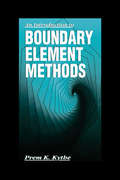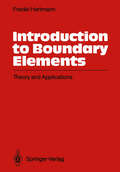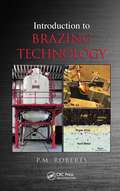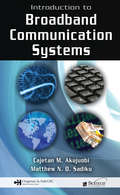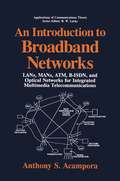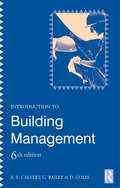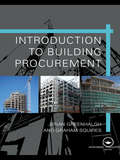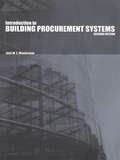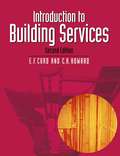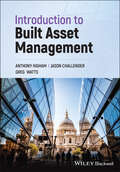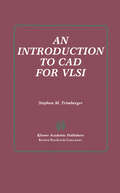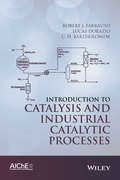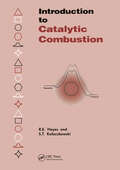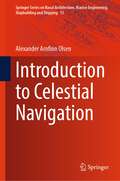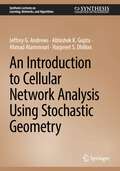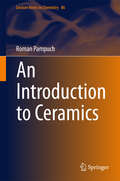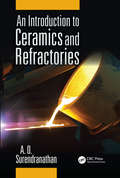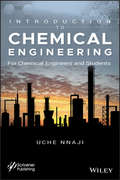- Table View
- List View
An Introduction to Boundary Element Methods
by Prem K. KytheThe finite element and the boundary element methods are the two most important developments in numerical mathematics to occur in this century. Many engineering and mathematics graduate curricula now include a course in boundary element methods. Such a course must cover numerical methods, basic methodology to real problems, and interactive computer usage. Both theory and applications, necessary for applied courses, are available in this new textbook.An Introduction to Boundary Element Methods is logically organized and easy to read. The topics are carefully selected and meticulously presented. Applications are described for use in identifying potential problems and for heat transfer, diffusion equations, linear elasticity, water waves, ocean acoustics, acoustic scattering, aerodynamics, porous media, and simple laminar flows.More than 20 computer subroutines help develop and explain the computational aspect of the subject. Hundreds of figures, exercises, and solved examples supplement text and help clarify important information.The computer programs have been tested on some benchmark problems. Even in single precision the results are more accurate and better than those obtained from available Fortran programs.
An Introduction to Boundary Element Methods (Symbolic And Numeric Computation Ser. #4)
by Prem K. KytheThe finite element and the boundary element methods are the two most important developments in numerical mathematics to occur in this century. Many engineering and mathematics graduate curricula now include a course in boundary element methods. Such a course must cover numerical methods, basic methodology to real problems, and interactive computer usage. Both theory and applications, necessary for applied courses, are available in this new textbook.An Introduction to Boundary Element Methods is logically organized and easy to read. The topics are carefully selected and meticulously presented. Applications are described for use in identifying potential problems and for heat transfer, diffusion equations, linear elasticity, water waves, ocean acoustics, acoustic scattering, aerodynamics, porous media, and simple laminar flows.More than 20 computer subroutines help develop and explain the computational aspect of the subject. Hundreds of figures, exercises, and solved examples supplement text and help clarify important information.The computer programs have been tested on some benchmark problems. Even in single precision the results are more accurate and better than those obtained from available Fortran programs.
Introduction to Boundary Elements: Theory and Applications
by Friedel Hartmannto Boundary Elements Theory and Applications With 194 Figures Springer-Verlag Berlin Heidelberg New York London Paris Tokyo Hong Kong Dr.-Ing. Friedel Hartmann University of Dortmund Department of Civil Engineering 4600 Dortmund 50 FRG ISBN-13: 978-3-642-48875-7 e-ISBN-13: 978-3-642-48873-3 001: 10.1007/978-3-642-48873-3 Library of Congress Cataloging-in-Publication Data Hartmann, F. (Friedel) Introduction to boundary elements: theory and applications/Friedel Hartmann. ISBN-13: 978-3-642-48875-7 1. Boundary value problems. I. Title. TA347.B69H371989 515.3'5--dc19 89-4160 This work is subject to copyright. All rights are reserved, whether the whole or part of the material is concerned, specifically the rights of translation, reprinting, re-use of illustrations, recitation, broadcasting, reproduction on microfilms or in other ways, and storage in data banks. Duplication of this publication or parts thereof is only permitted under the provision of the German Copyright Law of September 9,1965, in its version of June 24,1985, and a copyright fee must always be paid. Violations fall under the prosecution act of the German Copyright Law. © Springer-Verlag Berlin Heidelberg 1989 Softcover reprint of the hardcover 1 st edition 1989 The use of registered names, trademarks, etc. in this publication does not imply, even in the absence of a specific statement, that such names are exempt from the relevant protective laws and regulations and therefore free for general use.
Introduction to Brazing Technology
by P.M RobertsIntroduction to Brazing Technology provides practical guidance for the industrial production of an effectively brazed joint. Written in plain language by an active technical consultant with more than 50 years of brazing experience, this clear and concise book:Explains the fundamental concepts of the brazing processCovers all the common heating meth
Introduction to Broadband Communication Systems
by Cajetan M. AkujuobiBroadband networks, such as asynchronous transfer mode (ATM), frame relay, and leased lines, allow us to easily access multimedia services (data, voice, and video) in one package. Exploring why broadband networks are important in modern-day telecommunications, Introduction to Broadband Communication Systems covers the concepts and components of bot
An Introduction to Broadband Networks: LANs, MANs, ATM, B-ISDN, and Optical Networks for Integrated Multimedia Telecommunications (Applications of Communications Theory)
by Anthony S. AcamporaThis is an elementary textbook on an advanced topic: broadband telecommunica tion networks. I must declare at the outset that this book is not primarily intended for an audience of telecommunication specialists who are weIl versed in the concepts, system architectures, and underlying technologies of high-speed, multi media, bandwidth-on-demand, packet-switching networks, although the techni caIly sophisticated telecommunication practitioner may wish to use it as a refer ence. Nor is this book intended to be an advanced textbook on the subject of broadband networks. Rather, this book is primarily intended for those eager to leam more about this exciting fron tier in the field of telecommunications, an audience that includes systems designers, hardware and software engineers, en gineering students, R&D managers, and market planners who seek an understand ing of local-, metropolitan-, and wide-area broadband networks for integrating voice, data, image, and video. Its primary audience also includes researchers and engineers from other disciplines or other branches of telecommunications who anticipate a future involvement in, or who would simply like to leam more about, the field of broadband networks, along with scientific researchers and corporate telecommunication and data communication managers whose increasingly sophis ticated applications would benefit from (and drive the need for) broadband net works. Advanced topics are certainly not ignored (in fact, a plausible argument could be mounted that aIl of the material is advanced, given the infancy of the topic).
Introduction to Building Management
by D. Coles G. Bailey R E CalvertThis is the classic practical introduction to the broad principles of building management. It is suitable for both students and practising construction professionals who are concerned with greater efficiency within the construction industry. As a general textbook for the student, the introduction covers the entire field in some depth providing a firm foundation for additional reading. The text is closely geared to the chartered Institute of Building (Member) Parts I and II examinations. The book includes examples based upon and related to working experience. It will also be found valuable by students reading for the examinations of other professional bodies in the construction industry, and by HNC/D students.
Introduction to Building Management
by D. Coles G. Bailey R E CalvertThis is the classic practical introduction to the broad principles of building management. It is suitable for both students and practising construction professionals who are concerned with greater efficiency within the construction industry. As a general textbook for the student, the introduction covers the entire field in some depth providing a firm foundation for additional reading. The text is closely geared to the chartered Institute of Building (Member) Parts I and II examinations. The book includes examples based upon and related to working experience. It will also be found valuable by students reading for the examinations of other professional bodies in the construction industry, and by HNC/D students.
Introduction to Building Procurement
by Brian Greenhalgh Graham SquiresIntroduction to Building Procurement familiarises the reader with the principles and methods of the procurement of buildings, starting at the most basic level. Starting with introductory chapters that explain the structure of the construction industry, the nature of clients, and the historical development of the procurement methods in use today, the book goes on to address core procurement tasks. It is the ideal introductory textbook for professionals and undergraduates studying quantity surveying, construction project management and construction commercial management.
Introduction to Building Procurement (PDF)
by Brian Greenhalgh Graham SquiresThe procurement stage of the building process is critical to the success of any building project, and as such must be understood by everybody entering the industry. Introduction to Building Procurement is designed to familiarize the novice with the principles and methods of building procurement, starting at the most basic level. With chapter summaries and tutorial questions provided throughout the book, the reader will get to grips with the following topics: the structure of the construction industry the nature of clients the historical development of building procurement methods the roles and responsibilities carried out in any project. Having developed the necessary background knowledge, the reader is then introduced to the more complex aspects of procurement in detail, such as: methods of paying contractors the main procurement routes in use standard forms of contract. The concluding chapter discusses emerging procurement trends, and speculates on future developments to bring the reader right up to speed with the modern industry. With its clear layout and highly accessible approach, Introduction to Building Procuremen is the perfect introductory text for undergraduate students and professionals starting out on a career in quantity surveying, construction project management or construction commercial management.
An Introduction to Building Procurement Systems
by J.W.E. Masterman Dr Jack Masterman Jack MastermanFirst Published in 2003. Routledge is an imprint of Taylor & Francis, an informa company.
An Introduction to Building Procurement Systems
by J.W.E. Masterman Dr Jack Masterman Jack MastermanFirst Published in 2003. Routledge is an imprint of Taylor & Francis, an informa company.
Introduction to Building Services (Building and Surveying Series)
by E.F. Curd Chris HowardThis book provides a sound insight into the complex and wide ranging field of building services. It will appeal as a textbook to HND students of building services engineering as well as to undergraduate students of quantity and building surveying, estate management, building, and architecture and related disciplines, all of whom are normally required to take an introductory course in building services In this thoroughly revised new edition, which has been fully updated, both the theoretical and practical content has been expanded. In particular, the chapters covering cold water provision, drainage, heating, mechanical ventilation, air conditioning and electricity installations have been enlarged significantly and many new diagrams added. All of these improvements are designed to help students to understand the nature, use and operation of the most commonly installed building services.
Introduction to Built Asset Management
by Anthony Higham Jason Challender Greg WattsIntroduction to Built Asset Management Provides a multidisciplinary introduction to building maintenance management and execution, covering a wide range of current technical and management issues The maintenance and upgrading of existing buildings is no longer viewed as separate from the operational phase of the completed building. Maintenance and management are now regarded as fundamental parts of a building’s life cycle, forming a significant percentage of the construction industry’s total output. As higher education programmes in the UK and elsewhere continue to place greater emphasis on the longer-term view of construction projects, students and instructors require a thorough and up-to-date textbook that emphasises the comprehensive nature of building maintenance. Introduction to Built Asset Management is a systematic introduction to both the technology and management issues central to building maintenance and refurbishment. Covering the entire life cycle of built assets, the textbook reviews the role of framework agreements, describes key performance indicators, discusses recent advancements in the procurement of maintenance activities and more. Detailed yet accessible chapters include illustrative examples, seminar questions and self-assessment tasks that enable students to measure their progress as they work through the material. Designed to meet the needs of today’s learners, this much-needed textbook: Addresses a variety of both environmental and commercial concerns Evaluates important concepts of sustainability, sustainable maintenance and carbon resilience Discusses the growing retrofit market in the wider context of asset management and maintenance Describes information management tools such as building information modelling (BIM) and geographic information systems (GIS) Introduction to Built Asset Management is ideally suited for courses in construction, construction management, building surveying and facilities management with modules in built asset management and maintenance.
Introduction to Built Asset Management
by Anthony Higham Jason Challender Greg WattsIntroduction to Built Asset Management Provides a multidisciplinary introduction to building maintenance management and execution, covering a wide range of current technical and management issues The maintenance and upgrading of existing buildings is no longer viewed as separate from the operational phase of the completed building. Maintenance and management are now regarded as fundamental parts of a building’s life cycle, forming a significant percentage of the construction industry’s total output. As higher education programmes in the UK and elsewhere continue to place greater emphasis on the longer-term view of construction projects, students and instructors require a thorough and up-to-date textbook that emphasises the comprehensive nature of building maintenance. Introduction to Built Asset Management is a systematic introduction to both the technology and management issues central to building maintenance and refurbishment. Covering the entire life cycle of built assets, the textbook reviews the role of framework agreements, describes key performance indicators, discusses recent advancements in the procurement of maintenance activities and more. Detailed yet accessible chapters include illustrative examples, seminar questions and self-assessment tasks that enable students to measure their progress as they work through the material. Designed to meet the needs of today’s learners, this much-needed textbook: Addresses a variety of both environmental and commercial concerns Evaluates important concepts of sustainability, sustainable maintenance and carbon resilience Discusses the growing retrofit market in the wider context of asset management and maintenance Describes information management tools such as building information modelling (BIM) and geographic information systems (GIS) Introduction to Built Asset Management is ideally suited for courses in construction, construction management, building surveying and facilities management with modules in built asset management and maintenance.
An Introduction to CAD for VLSI
by Stephen M. TrimbergerThe last decade has seen an explosion in integrated circuit technology. Improved manufacturing processes have led to ever smaller device sizes. Chips with over a hundred thousand transistors have become common and performance has improved dramatically. Alongside this explosion in manufacturing technology has been a much-less-heralded explosion of design tool capability that has enabled designers to build those large, complex devices. The tools have allowed designers to build chips in less time, reducing the cost and risk. Without the design tools, we would not now be seeing the full benefits of the advanced manufacturing technology. The Scope of This Book This book describes the implementation of several tools that are commonly used to design integrated circuits. The tools are the most common ones used for computer aided design and represent the mainstay of design tools in use in the industry today. This book describes proven techniques. It is not a survey of the newest and most exotic design tools, but rather an introduction to the most common, most heavily-used tools. It does not describe how to use computer aided design tools, but rather how to write them. It is a view behind the screen, describing data structures, algorithms and code organization. This book covers a broad range of design tools for Computer Aided Design (CAD) and Computer Aided Engineering (CAE). The focus of the discussion is on tools for transistor-level physical design and analysis.
Introduction to Catalysis and Industrial Catalytic Processes
by Robert J. Farrauto Lucas Dorazio C. H. BartholomewIntroduces major catalytic processes including products from the petroleum, chemical, environmental and alternative energy industries Provides an easy to read description of the fundamentals of catalysis and some of the major catalytic industrial processes used today Offers a rationale for process designs based on kinetics and thermodynamics Alternative energy topics include the hydrogen economy, fuels cells, bio catalytic (enzymes) production of ethanol fuel from corn and biodiesel from vegetable oils Problem sets of included with answers available to faculty who use the book Review:"In less than 300 pages, it serves as an excellent introduction to these subjects whether for advanced students or those seeking to learn more about these subjects on their own time...Particularly useful are the succinct summaries throughout the book...excellent detail in the table of contents, a detailed index, key references at the end of each chapter, and challenging classroom questions..." (GlobalCatalysis.com, May 2016)
Introduction to Catalysis and Industrial Catalytic Processes
by Robert J. Farrauto Lucas Dorazio C. H. BartholomewIntroduces major catalytic processes including products from the petroleum, chemical, environmental and alternative energy industries Provides an easy to read description of the fundamentals of catalysis and some of the major catalytic industrial processes used today Offers a rationale for process designs based on kinetics and thermodynamics Alternative energy topics include the hydrogen economy, fuels cells, bio catalytic (enzymes) production of ethanol fuel from corn and biodiesel from vegetable oils Problem sets of included with answers available to faculty who use the book Review:"In less than 300 pages, it serves as an excellent introduction to these subjects whether for advanced students or those seeking to learn more about these subjects on their own time...Particularly useful are the succinct summaries throughout the book...excellent detail in the table of contents, a detailed index, key references at the end of each chapter, and challenging classroom questions..." (GlobalCatalysis.com, May 2016)
Introduction to Catalytic Combustion
by R.E. HayesIn a clear and concise manner, this book explains how to apply concepts in chemical reaction engineering and transport phenomena to the design of catalytic combustion systems. Although there are many textbooks on the subject of chemical reaction engineering, catalytic combustion is mentioned either only briefly or not at all. The authors have chosen three examples where catalytic combustion is utilized as a primary combustion process and natural gas is used as a fuel - stationary gas turbines, process fluid heaters, and radiant heaters; these cover much of the area where research is currently most active. In each of these there are clear environmental benefits to be gained illustrating catalytic combustion as a "cleaner primary combustion process" . The dominant heat transfer processes in each of the applications are different, as are the support systems, flow geometrics and operating conditions.
Introduction to Catalytic Combustion
by R.E. HayesIn a clear and concise manner, this book explains how to apply concepts in chemical reaction engineering and transport phenomena to the design of catalytic combustion systems. Although there are many textbooks on the subject of chemical reaction engineering, catalytic combustion is mentioned either only briefly or not at all. The authors have chosen three examples where catalytic combustion is utilized as a primary combustion process and natural gas is used as a fuel - stationary gas turbines, process fluid heaters, and radiant heaters; these cover much of the area where research is currently most active. In each of these there are clear environmental benefits to be gained illustrating catalytic combustion as a "cleaner primary combustion process" . The dominant heat transfer processes in each of the applications are different, as are the support systems, flow geometrics and operating conditions.
Introduction to Celestial Navigation (Springer Series on Naval Architecture, Marine Engineering, Shipbuilding and Shipping #15)
by Alexander Arnfinn OlsenThis book focuses on Coastal and Ocean Navigation with an emphasis on celestial navigation techniques as a ‘back up’ in the event digital technologies fail.It deals with the main themes and principles of celestial navigation (including time). It covers the syllabus for deck officers working towards the Officer of the Watch (OOW) certificate of competence (COC) awarded by the Maritime and Coastguard Agency (MCA), and for Royal Navy navigation officers working towards achieving the equivalent Navigational Watch Certificate (NWC). The NWC is equivalent to the certificate awarded by the MCA to OOWs in the Merchant Service under the international Standardisation of Training, Certification and Watchkeeping (STCW) agreements. The detailed theory of celestial navigation is provided.
An Introduction to Cellular Network Analysis Using Stochastic Geometry (Synthesis Lectures on Learning, Networks, and Algorithms)
by Jeffrey G. Andrews Abhishek K. Gupta Ahmad Alammouri Harpreet S. DhillonThis book provides an accessible yet rigorous first reference for readers interested in learning how to model and analyze cellular network performance using stochastic geometry. In addition to the canonical downlink and uplink settings, analyses of heterogeneous cellular networks and dense cellular networks are also included. For each of these settings, the focus is on the calculation of coverage probability, which gives the complementary cumulative distribution function (ccdf) of signal-to-interference-and-noise ratio (SINR) and is the complement of the outage probability. Using this, other key performance metrics, such as the area spectral efficiency, are also derived. These metrics are especially useful in understanding the effect of densification on network performance. In order to make this a truly self-contained reference, all the required background material from stochastic geometry is introduced in a coherent and digestible manner.This Book:Provides an approachable introduction to the analysis of cellular networks and illuminates key system dependenciesFeatures an approach based on stochastic geometry as applied to cellular networks including both downlink and uplinkFocuses on the statistical distribution of signal-to-interference-and-noise ratio (SINR) and related metrics
An Introduction to Ceramics (Lecture Notes in Chemistry #86)
by Roman PampuchThis book embraces both traditional and advanced ceramics produced from synthetic or deeply transformed natural raw materials. Following the path of ceramic innovation, this introduction explains electric properties of ceramic conductors, like high-temperature superconductors, reflects on the interaction of material and electromagnetic radiation, presents the importance of voids and defects in the material, and provides an outlook on most recent developments in the field of ceramics, such as smart or self-healing materials . It provides a quick grasp of the main points of ceramic thinking and is an ideal starting point for students in the field of chemistry, materials science or solid state physics.
An Introduction to Ceramics and Refractories
by A. O. SurendranathanAll Refractories Are Ceramics but Not All Ceramics Are RefractoriesCeramics and refractories cover a wide range of fields and applications, and their relevance can be traced as far back as 24,000 BC to the first man-made piece of earthenware, and as recently as the late 1900s when ceramics and ceramic matrix composites were developed to withstand u
Introduction to Chemical Engineering: For Chemical Engineers and Students
by Uche P. NnajiThe field of chemical engineering is undergoing a global “renaissance,” with new processes, equipment, and sources changing literally every day. It is a dynamic, important area of study and the basis for some of the most lucrative and integral fields of science. Introduction to Chemical Engineering offers a comprehensive overview of the concept, principles and applications of chemical engineering. It explains the distinct chemical engineering knowledge which gave rise to a general-purpose technology and broadest engineering field. The book serves as a conduit between college education and the real-world chemical engineering practice. It answers many questions students and young engineers often ask which include: How is what I studied in the classroom being applied in the industrial setting? What steps do I need to take to become a professional chemical engineer? What are the career diversities in chemical engineering and the engineering knowledge required? How is chemical engineering design done in real-world? What are the chemical engineering computer tools and their applications? What are the prospects, present and future challenges of chemical engineering? And so on. It also provides the information new chemical engineering hires would need to excel and cross the critical novice engineer stage of their career. It is expected that this book will enhance students understanding and performance in the field and the development of the profession worldwide. Whether a new-hire engineer or a veteran in the field, this is a must—have volume for any chemical engineer’s library.
